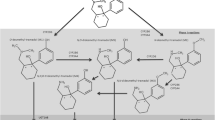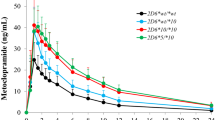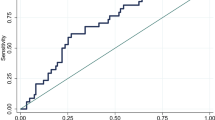Abstract
Background and objective: Tramadol is metabolized by the highly polymorphic enzyme cytochrome P450 (CYP)2D6. Patients with different CYP2D6 genotypes may respond differently to tramadol in terms of pain relief and adverse events. In this study, we compare the pharmacokinetics and effects of tramadol in Malaysian patients with different genotypes to establish the pharmacokinetic-pharmacodynamic relationship of tramadol.
Study design and setting: All patients received an intravenous dose of tramadol 100mg as their first postoperative analgesic. Blood was sampled at 0 minutes and subsequently at 15 and 30 minutes, 1, 2, 4, 8, 16, 20, and 24 hours for serum tramadol and analyzed by high-performance liquid chromatography (HPLC). Patients were genotyped for CYP2D6*1, *3, *4, *5, *9, *10, and *17 alleles and duplication of the gene by means of an allele-specific PCR. Pain was measured using the Visual Analog Scales, and adverse effects were recorded.
Results: About half of the patients had the wild-type allele (CYP2D6*1), with the ‘Asian’ CYP2D6* 10 allele accounting for most of the rest (40%). None of the genotypes predicted poor metabolism. Twenty-seven percent of the patients were intermediate metabolizers (IM) and 2.9% were ultra-rapid (UM) metabolizers; the remaining 70% were extensive metabolizers (EM). The mean total clearance (CL) predicted by the model was lower (19 L/h) and the half-life longer (5.9 hours) than those reported in Western populations. This may due to the high frequency of the CYP2D6*10 allele amongst Malaysian patients. The UM and EM groups had 2.6- and 1.3-times faster CL, respectively, than the IM. CL was 16, 18, 23, and 42 L/h while mean half-lives were 7.1, 6.8, 5.6, and 3.8 hours among the IM, EM1, EM2, and UM groups, respectively. However, the analgesic effects of tramadol were not measured adequately among the postoperative patients to establish its full therapeutic effects. There were significant differences in the adverse-effect profiles amongst the various genotype groups, with the IM group experiencing more adverse effects than the EM, and the EM having more adverse effects than the UM.
Conclusion: CYP2D6 activity may play an important role in determining the pharmacokinetics of tramadol and in predicting its adverse effects. If these results can be confirmed in a larger population, genotyping may be an important tool in determining the dose of tramadol.












Similar content being viewed by others
References
Raffa RB, Friderichs E, Reimann W, et al. Opioid and non-opioid components independently contribute to the mechanism of action of tramadol, an “atypical” opioid analgesic. J Pharmacol Exp Ther 1992; 260: 275–85
Lewis KS, Han NH. Tramadol: a new centrally-acting analgesia. Am J Health Syst Pharm 1997; 54: 643–52
Lee R, McTavish D, Sorkin EM. Tramadol: a preliminary review of its pharmacodynamic and pharmacokinetic properties and therapeutic potential in acute and chronic pain states. Drugs 1993; 46: 313–40
Eichelbaum M, Evert B. Influence of pharmacogenetic on drug disposition and response. Clin Exp Pharmacol Physiol 1996; 23: 983–5
Meyer UA, Zanger UM. Molecular mechanisms of genetic polymorphisms of drug metabolism. Annu Rev Pharmacol Toxicol 1997; 37: 269–96
Ingelman-Sundberg M, Oscarson M, McLellan RA, et al. Polymorphic human cytochrome P450 enzymes, an opportunity for individualized drug treatment. Trends Pharmacol Sci 1999; 20: 342–9
Linder MW, Valdes R. Pharmacogenetics in the practise of laboratory medicine. Mol Diagn 1999; 4: 365–79
Wolf CR, Smith G. Pharmacogenetics: impact of genomics on healthcare. Br Med Bull 1999; 55(2): 366–86
Teh LK, Ismail R, Yusof R, et al. Heterogeneity of the CYP2D6 gene among Malays in Malaysia. J Clin Pharm Ther 2001; 26: 1–7
Leathart JBS, London SJ, Steward A, et al. CYP2D6 phenotype-genotype relationships in African-American and Caucasians in Los Angeles. Pharmacogenetics 1998; 8: 529–41
Aklillu E, Persson I, Bertilsson L, et al. Frequent distribution of ultrarapid metabolizers of debrisoquine in an Ethiopian population carrying duplicated and multiduplicated functional CYP2D6 alleles. J Pharmacol Exp Ther 1996; 278: 441–6
Ozdemir V, Shear NH, Kalow W. What will be the role of pharmacogenetics in evaluating drug safety and minimising adverse effects? Drug Saf 2001; 24(2): 75–85
Budd K, Langford R. Tramadol revisited. Br J Anaesth 1999; 82: 493–5
Bamigbade TA, Langford RM. Tramadol hydrochloride: an overview of current use. Hosp Med 1998; 59(5): 373–6
Austin KL, Stapleton JV, Mather LE. Multiple intramuscular injections: a major source of variability in analgesic response to meperidine. Pain 1980; 8: 47–62
Bingle JG, O’Connor TP, Evans WO, et al. The effect of “detailing” on physician’s behaviour for postsurgical narcotic analgesia. Pain 1991; 45: 171–3
Oates JDL, Snowdon SL, Jayson DWH. Failure of pain relief after surgery. Anaesthesia 1994; 49: 755–8
Sunshine A. New clinical experience with tramadol. Drugs 1994; 47Suppl. 1: 9–18
Lehmann KA. Tramadol for the management of acute pain. Drugs 1994; 47Suppl. 1: 19–32
Tucker GT. Clinical implications of genetic polymorphism in drug metabolism. J Pharm Pharmacol 1994; 46Suppl. 1: 417–24
Chen S, Chou WH, Blouin RA, et al. The cytochrome P450-2D6 (CYP2D6) enzyme polymorphism: screening costs and influence on clinical outcome in psychiatry. Clin Pharmacol Ther 1996; 60: 522–34
Armstrong M, Daly AK, Blennerhassett R, et al. Antipsychotic drug-induced movement disorders in schizophrenics in relation to CYP2D6 genotype. Br J Psychiatry 1997; 170: 23–6
Spina E, Gitto C, Avenso A, et al. Relationship between plasma desipramine levels, CYP2D6 phenotype and clinical response to desipramine: a prospective study. Eur J Clin Pharmacol 1997; 51: 395–8
Jelliffe R, Bayard D, Milman M. Achieving target goals most precisely using nonparametric compartmental models and multiple model: design of dosage regimens. Ther Drug Monit 2000; 22: 346–53
Jelliffe R, Schumitzky A, Bayard D, et al. Model-based, goal-oriented individualised drug therapy: linkage of population modelling, new “multiple model” dosage design, Bayesian feedback and individualised target goals. Clin Pharmacokinet 1998; 34: 57–77
Gan SH, Ismail R, Wan Adnan WA, et al. Population pharmacokinetic modeling of tramadol with application of the NPEM algorithms. J Clin Pharm Ther 2004; 29: 455–63
Pickard NA. Collection and handling of patient specimens. In: Kaplan LA, Pesce AJ, editors. Clinical chemistry: theory, analysis and correlation. Toronto (ON): CV Mosby Co., 1990: 40–8
Johansson I, Oscarson M, Yue QY, et al. Genetic analysis of the Chinese cytochrome P450 2D locus: characterization of variant CYP2D6 genes present in subjects with diminished capacity for debrisoquine hydroxylation. Mol Pharmacol 1994; 46(3): 452–9
Heim M, Meyer UA. Genotyping of poor metabolizers of debrisoquine by allele-specific PCR amplification. Lancet 1990; 336: 529–32
Steen VM, Andreassen OA, Daly AK, et al. Detection of the poor-metabolizer associated CYP2D6(D) gene deletion allele by long-PCR technology. Pharmacogenetics 1995; 5: 215–23
Tyndale R, Aoyama T, Broly F, et al. Identification of a new variant CYP2D6 allele lacking the codon encoding Lys-281: possible association with the poor metabolizer phenotype. Pharmacogenetics 1991; 1: 26–32
Masimirembwa C, Persson I, Bertilsson L, et al. A novel mutant variant of CYP2D6 gene (CYP2D6*17) common in a Black African population: association with diminished debrisoquine hydroxylase activity. Br J Clin Pharmacol 1996; 42: 713–9
Chou WH, Yan FX, de Leon J, et al. Impact from the cytochrome P450 2D6 polymorphism on outcome and costs associated with severe mental illness: extension of a pilot study. J Clin Psychopharmacol 2000; 20(2): 246–51
Gan SH, Ismail R. Validation of a high-performance liquid chromatography method for tramadol and O-desmethyltramadol in human plasma using solid-phase extraction. J Chromatogr B Biomed Sci Appl 2001; 759: 325–35
Lintz W, Beier H, Gerloff J. Bioavailability of tramadol after IM injection in comparison to IV infusion. Int J Clin Pharmacol Ther 1999; 37: 175–83
Ho K, Spence J, Murphy MF. Review of pain measurement tools. Ann Emerg Med 1996; 27(4): 427–32
Jelliffe R, Schumitzky A, Van Guilder M, et al. User manual for version 10.7 of the USC*PACK collection of PC programmes. Los Angeles (CA): Laboratory of Applied Pharmacokinetics, University of Southern California School of Medicine, 1995: 57–69
Whiting B, Kelman AW, Grevel J. Population pharmacokinetics: theory and application. Clin Pharmacokinet 1986; 11: 387–401
Jelliffe R, Gomis P, Tahani B, et al. A population pharmacokinetic model of trimethoprim in patients with pneumocystis pneumonia, made with parametric and nonparametric methods. Ther Drug Monit 1997; 19: 450–9
Chen S, Kumar S, Chou WH. A genetic bias in clinical trials? Cytochrome P450-2D6 (CYP2D6) genotype in general vs selected healthy subject populations. Br J Clin Pharmacol 1997; 44: 303–5
Gonzalez FJ, Meyer UA. Molecular genetics of the debrisoquine-sparteine polymorphism. Clin Pharmacol Ther 1991; 50: 233–8
Evans WE, Relling MV. Concordance of P450 2D6 (debrisoquine hydroxylase) phenotype and genotype: inability of dextromethorphan metabolic ratio to discriminate reliably heterozygous and homozygous gene. Pharmacogenetics 1991; 1: 143–8
Lehmann KA, Kratzenberg U, Schroeder-Bark B, et al. Postoperative patient-controlled analgesia with tramadol: analgesic efficacy and minimum effective concentration. Clin J Pain 1990; 6: 212–20
Tarradell R, Pol O, Farre M, et al. Respiratory and analgesic effects of meperidine and tramadol in patients undergoing orthopaedic surgery. Methods Find Exp Clin Pharmacol 1996; 18(3): 211–8
Follin SL, Charland SL. Acute pain management: operative or medical procedures and trauma. Ann Pharmacother 1997; 31(9): 1068–76
Rau T, Wohlleben G, Wuttke H, et al. CYP2D6 genotype: impact on adverse effects and nonresponse during treatment with antidepressants: a pilot study. Clin Pharmacol Ther 2004; 75(5): 386–93
Acknowledgments
This study was supported, in part, by a grant from the Ministry of Science, Technology and Environment of Malaysia (MOSTI).
Tramadol for high-performance liquid chromatography (HPLC) was donated by Grünenthal, Germany. We thank Mr Tengku Azaha for his skillful technical assistance in preparing the samples and operating the HPLC system, Dr Jennie Wong of the National University of Singapore for providing a positive control for CYP2D6*5, Professor Inger Johansson of Karolinska Institutet, Sweden, for providing a positive control for CYP2D6*10, and Dr rer. nat. Ulrich Griese of the Dr Margarete Fischer-Bosch-Institut fuer Klinische Pharmakologie Auerbachstr for providing positive controls for CYP2D6*3 and *4. Special thanks to Professor Roger Jelliffe (Professor of Medicine, Laboratory of Applied Pharmacokinetics, University of Southern California, USA) for his invaluable advice on population pharmacokinetic modeling.
The authors have no conflicts of interest that are directly relevant to the content of this study.
Author information
Authors and Affiliations
Corresponding author
Rights and permissions
About this article
Cite this article
Hua Gan, S., Ismail, R., Adnan, W.A.W. et al. Impact of CYP2D6 Genetic Polymorphism on Tramadol Pharmacokinetics and Pharmacodynamics. Mol Diag Ther 11, 171–181 (2007). https://doi.org/10.1007/BF03256239
Published:
Issue Date:
DOI: https://doi.org/10.1007/BF03256239




